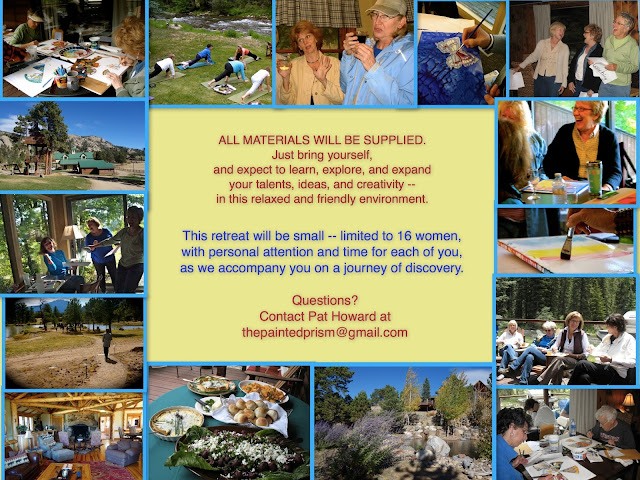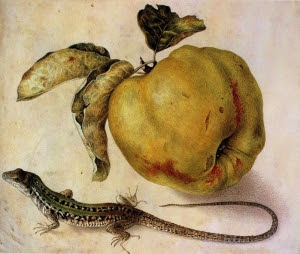Painted Prism Art Retreat
in Estes Park, Colorado
July 14-17, 2016
Join us for 3 days and 4 nights in the Rocky Mountains
to paint and create, to rest and rejuvenate, to learn and share.
This Art Retreat will offer you a unique opportunity to immerse yourself in art --
in an incredibly beautiful setting
for a truly special experience!
PRICE: $450, which includes tuition & supplies
Early Bird Special: $375 (before May 15)
TO REGISTER, with a deposit of $150, click here.
The balance of $300, will be due by July 1st.
Your Tuition includes:
- All materials and supplies for the 3 days of workshops
- Breakfast and lunch every day
- Snacks, water, coffee, and tea -- throughout the day
- Wine and cheese, for the evening gatherings
- 3 days of Art Workshops with Pat Howard
- Opening and closing gatherings, every day
- Yoga sessions every morning (optional)
- Time for yourself -- to meditate, play, walk, hang out, nap
- Unlimited fresh mountain air, laughter, and friendship
The balance of $300, will be due by July 1st.
Your Tuition includes:
- All materials and supplies for the 3 days of workshops
- Breakfast and lunch every day
- Snacks, water, coffee, and tea -- throughout the day
- Wine and cheese, for the evening gatherings
- 3 days of Art Workshops with Pat Howard
- Opening and closing gatherings, every day
- Yoga sessions every morning (optional)
- Time for yourself -- to meditate, play, walk, hang out, nap
- Unlimited fresh mountain air, laughter, and friendship
____________________________________
The Retreat will flow through yoga, writing, drawing, and painting,
with a few surprises thrown in, each day.
In addition to lots of watercolor painting,
your days will be a nice balance of learning, connecting, creating, reflecting, and sharing.
______________________________________
At the Painted Prism Art Retreat, you will:
- Fill your sketchbook/journal with sketches, Super Doodles, and writing.
- Work with watercolor, pencils, pens, liquid acrylic, markers, and collaging.
- Complete 2 or 3 Painting Projects -- including Mandalas, Aquabord, Negative Painting
- Come together for Group Activities -- with intention, meaning, and fun, of course.
We will be staying and painting and playing here at Aspen Falls, a beautiful private mountain retreat in Estes Park -- set on 30 acres, with a lake and gorgeous Rocky Mountain views.
LODGING: Available on-site, at an additional cost
If you choose to stay with us on-site, at an additional, but very affordable, cost --
you'll have the option of staying in the main house, in one of the 4 cabins on the property, or in the barn/studio. Lodging information, with prices and details, is available. Contact Pat at thepaintedprism@gmail.com
ITINERARY
Thursday, 7/14 -- Check in between 3 and 6 pm. Welcome Reception at 5 pm.
Friday through Sunday, 7/15-17 -- Our days will begin with a light breakfast, coffee, and tea.
Then, relaxing and energizing movement -- yoga session, a jog, or a walk around the grounds.
The Art Workshops will start each day at 9:30 am. We will be involved in art lessons and projects for 5+ hours each day -- with time out for lunch.
At the end of each day, we'll gather together at the main house -- for sharing, reflecting, story-telling, connecting -- and enjoying a glass of wine.
Monday, 7/18 -- The Retreat will end after breakfast on Monday morning.
This Retreat will be small -- limited to 16 women --
with personal attention and time for each of you,
as we accompany you on a journey of discovery.
__________________________________________
About the Retreat Leaders:
Pat Howard is a watercolor artist and teacher, who lives in Durango, Colorado. Her artist/teaching blog, The Painted Prism, averages 1,000 visits a day. Pat's Watercolor Workshops, in Colorado, Ohio, and California, are always full, and she currently has 30 on-line mentoring students, from all around the world! Pat's watercolor paintings can be seen at Columbine Gallery, in Loveland, CO.
Cheryl Miller Thurston is an award-winning author, editor, and musician, who lives in Loveland, Colorado. She founded and ran a successful publishing company, Cottonwood Press, for 24 years. Her plays and musicals have been performed all over the country. Cheri writes the material for, directs, and plays the accordion for, the popular musical comedy performing group, Moonlighting Teachers.
__________________________
Questions? Contact Pat at: thepaintedprism@gmail.com
___________________________
To Register for the Painted Prism Art Retreat:
- You can secure your spot at this retreat, by paying a deposit of $150, HERE. The balance of $300 will be due by July 1st, 2016.
- You can also register by contacting Pat Howard at: thepaintedprism@gmail.com
- Once you register for the retreat, you will receive an e-mail from us, describing how to book your lodging for the retreat.
_____________________________
Hope you can join us in July,
for 3 days and 4 nights of creativity and fun
in Estes Park!










































